
Conical Screen Mills
Uni-Mill Series
The Uni-Mill conical screen mill draws upon Hanningfield's wealth of experience in size reduction for the process industries.
Conical screen or 'cone-milling' is ideal for achieving a fine, uniform particle size. By combining high throughput and high efficiency, the low energy Uni-Mill is perfect for the pharmaceutical, food, chemical and consumer goods industries.The Uni-Mill is designed and manufactured by Hanningfield Process Systems at their UK Headquarters.
- Profile
-
The Uni-Mill is suited to dry, wet or fine milling in the pharmaceutical, food, chemical and consumer goods industries. The mill can easily be adapted for use on different products, simply by changing the granulating screen, presenting a cost-effective solution to your size reduction requirement.
The Uni-Mill is available in various sizes to ensure all equipment is tailored to a customer’s specific requirements.The Uni-Mill conical screen mill balances performance with simplicity, to provide a solution that guarantees a high throughput but is easy to operate, clean and maintain. This durable design makes the Uni-Mill extremely reliable, perfect for even the most demanding of processing requirements.
- Method of Operation
-
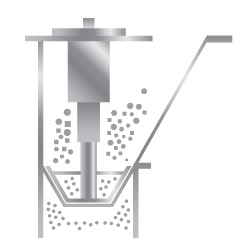 Unprocessed material is loaded into the product inlet of the Uni-Mill by hand, gravity feed or vacuum transfer. The material then passes into the milling chamber where a rotating impeller forces the unprocessed material through a stationery cone-shaped screen by a vortex action.
Unprocessed material is loaded into the product inlet of the Uni-Mill by hand, gravity feed or vacuum transfer. The material then passes into the milling chamber where a rotating impeller forces the unprocessed material through a stationery cone-shaped screen by a vortex action.
The material is instantly reduced in size as it passes through the holes in the screen.By changing a combination of screen, impeller shape and speed, the finished milled particle size can be carefully controlled.
Most important for hygienic requirements, such as those in pharmaceutical and food production, there is no metal-to-metal contact between the impeller and screen. - Features
- •Stainless steel construction
•Low maintenance, easy-clean design
•No metal-to-metal contact
•Can be integrated with vacuum transfer for high-throughput in-line milling
•Fail-safe design
•ATEX Versions available - Benefits
- •High throughput for maximum productivity
•Adaptable to various products for cost-effectiveness
•Easy to operate
•Low heat, dust and noise generation for improved working environment - Specifications
- •Material of Construction: Stainless steel (304 or 316)
•Throughput: 0-7,200 kgs/hr (0-16,000 lbs/hr)
•Noise: <85dB
•Minimum Particle Size Achievable: Approximately 150 microns
•Explosion Protection: ATEX or Non-ATEX version available - Typical Applications
-
Pharmaceutical
Dry milling for tablet manufacturing
Wet milling for tablet manufacturing
Deagglomeration of raw materials
Reclaiming powder from tablets and capsulesFood
Dry milling for food manufacturing
Wet milling for food manufacturing
Deagglomeration of raw materials
Reclaiming food to transform it to smaller pieces/powderChemical
Dry milling of chemical materials
Wet milling of chemical materials
Deagglomeration of raw materialsConsumer Goods
Dry milling for consumer goods manufacturing
Wet milling for consumer goods manufacturing
Deagglomeration of raw materials
Reclaiming of heat sensitive products to transform into a powder - Gallery
What is Cone Milling?
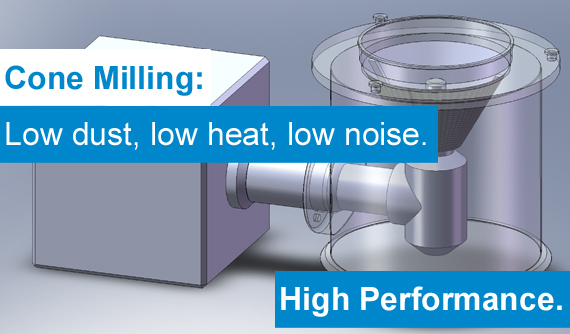 Conical Screen Milling, or simply 'Cone Milling', is widely recognised as one of the most efficient and beneficial methods for size reduction in the powder processing industries. Benefits of this method include a reduction in process times, cleaning, noise and dust levels, thus making this a highly desirable solution for size reduction of materials.
Conical Screen Milling, or simply 'Cone Milling', is widely recognised as one of the most efficient and beneficial methods for size reduction in the powder processing industries. Benefits of this method include a reduction in process times, cleaning, noise and dust levels, thus making this a highly desirable solution for size reduction of materials.
The Hanningfield ‘Uni-Mill’ conical screen mill draws upon our years of knowledge and expertise in size reduction for the process industries. The ‘Uni-Mill' can achieve a throughput of up to 7,200 kgs/hr making it a high productivity, low energy solution for the pharmaceutical, food, chemical and consumer goods industries.
How Does it Work?
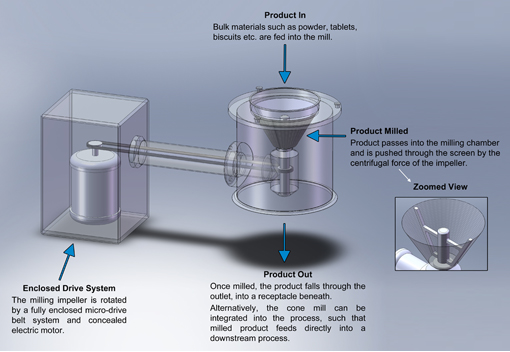 Material is fed into the cone mill via the in-feed chute, using hand-feed, gravity-feed or vacuum-feed. The material passes into the milling chamber, where the centrifugal force of the rotating impeller pushes material through the apertures of the screen (this process ensures that material will not pass through the screen until the particle is the desired size).
Material is fed into the cone mill via the in-feed chute, using hand-feed, gravity-feed or vacuum-feed. The material passes into the milling chamber, where the centrifugal force of the rotating impeller pushes material through the apertures of the screen (this process ensures that material will not pass through the screen until the particle is the desired size).
Once the material has passed through the screen, the finished product falls from the bottom of the mill to a receptacle beneath. Alternatively this can be integrated with various systems (such as Vacuum Transfer), such that milled product automatically passes to a downstream process.
'Low Dust, Low Heat, Low Noise' – Why is this important?
Low Dust: Minimal dust generation is important as excess powder escaping to the atmosphere can be harmful for operators and potentially hazardous to the operating environment. The ‘Uni-Mill’ cone mill produces comparatively little dust compared with many alternative milling processes. Moreover, the Uni-Mill can be integrated with various other pieces of equipment to create a totally-contained, dust-free milling process.
Low Heat: Ideally, a machine is used to process a material, not to change its core characteristics. The low heat generated by the Hanningfield ‘Uni-Mill’ means that the milled product is not altered by the temperature created during grinding. Moreover, many hygroscopic products do not fare well under high temperature conditions. By keeping the temperature optimised, the mill does not negatively affect the product.
Low Noise: Minimising noise is desirable to help comply with Health and Safety requirements for maintaining a safe working process environment.
What are the Typical Applications?
Typically cone mills are used for the size reduction and deagglomeration of powders, granules, tablets, foodstuffs etc across a wide variety of industries. A cone mill is generally used for reducing material to a particle size as low as 180µm (80 mesh).
Below are some common example applications:
Pharmaceutical: Milling powder, reclaiming tablets, sizing wet granulated particles before drying, sizing dry granulated particles before tabletting and more.
Food: Milling powder and spices etc., milling foodstuffs, deagglomerating dried fruits or other clumped material, reclaiming biscuits, reclaiming granola bars, reclaiming cereal and more.
Chemical: Milling powder, de-lumping raw material, wet granulation, reclaiming off-specification product.
Cosmetic: Milling powder, reclaiming off-specification product, de-lumping raw material.
Other: A cone mill can be used for size reduction of many different types of material, and for many different purposes. For more information and to discuss your specific requirements with our technical team, please contact us.
Achieving a Dust-Free Milling Process
Modern processes often use high potency APIs and other ingredients, which are potentially dangerous if mishandled - this is a particular concern during milling, a process which is notorious for generating dust. Hence, in order to protect both the operator and the process environment, it is important to consider various methods which could be used to help minimise this problem.
There are a number of ways to contain dust during cone milling, this article shall focus primarily on three methods; in-line vacuum transfer, container-to-container milling and milling inside an isolator. All three techniques offer an efficient and effective way to achieve dust-free milling.
In-line Vacuum Transfer
Feeding and discharging from a cone mill using a vacuum is a particularly effective method for achieving dust-free milling. This process not only contains the dust, but also automates the process and minimises waste - helping customers make efficiency savings.
Using an in-line vacuum transfer system (such as the Hanningfield Uni-Vac), material is automatically fed into the inlet chute, and is also automatically drawn from the outlet of the mill. This process ensures that from pick-up to discharge, the system is fully enclosed, preventing the escape of dust.
Container-to-Container Milling
This solution uses the principle of gravity to feed product through the mill. By positioning a bin above the mill, and another bin below the mill, product is released from the top IBC, milled, and then passes directly into the bottom IBC.
This creates a totally contained, in-line solution for milling. Not only does this contain the product during the milling phase, but this is also a simple and effective method for transferring product from bin-to-bin, and cone milling the product en-route.
Isolator Milling
One suggested method for the containment of such fine powder during milling, is the use of an isolator or 'glove-box' to ensure all excess material remains contained, ensuring the fine dust particles are not exposed to either atmosphere or operator.
Cone mill integration within the isolator is performed by means of through the wall fixing flange. This fixing flange and particular configuration of the cone mill allow for a physical division of the cone mill head by the technical area that is left outside the isolator. Thanks to this special configuration all cone mill cleaning operations are performed within the isolator by means of gloves or half-suit, reducing any risk of exposure for the operator and avoiding any transport to cleaning room.
Another benefit of isolator milling is for achieving a zoned area such as ATEX. The isolator itself creates an ATEX environment for milling, ensuring the entire process environment (including motors and controls) do not need to be changed to comply with the necessary requirements. Learn more about milling in an isolator below.
Conclusions:
In a modern process, containing dust is extremely important. This can be easily achieved during the cone milling stage, simply by employing one of the methods listed above. Each solution will be more or less suited to any particular application.
For more information on how to contain dust during processing, please just contact us.
Milling & Conveying
The following video shows the simultaneous application of Hanningfield 'Uni-Mill' and 'Uni-Vac' machines in milling material and transfering the output powder from point A to point B in a fast and efficient way:
Contained Milling: Utilising a Cone Mill inside an Isolator
A Technical Article by James Ellis (Hanningfield) and Stefano Butti (F.P.S. Food and Pharma Systems S.r.l.)
Contained Milling: Utilising a Cone Mill inside an Isolator
Abstract
Cone milling is one of the most prevalent methods of size reduction in the process industries. Due to the ever-increasing potency of process material (APIs etc) containment becomes an essential element of modern day processing considerations.
One suggested method for the containment of such fine powder during milling, is the use of an isolator to ensure all excess material remains contained, ensuring the fine dust particles are not exposed to either atmosphere or operator. Understanding when to use an isolator, and how to use it, can be essential to ensuring the milling process meets required and advised processing guidelines.
1. Introduction
The increasing popularity and potency of new pharmaceutical API's, HAPI's and sterile products makes the need for tailor-made containment a priority. This is necessary to continuously meet the required safety standards and to ensure an appropriate level of advanced technology is in place to support research activities, product developments and final production phases.

'The increasing potency of API's has made containment during milling a hot topic.'
This concern is particularly relevant in relation to mechanical milling methods, such as cone milling. Milling is a process which can generate fine dust particles - this is a problem which needs to be deeply analysed and investigated to ensure proper levels of containment, ergonomy and process accuracy are maintained. For this reason, choosing to integrate a mill with an isolator is a matter of acute technical importance.
Cone milling is one of the most common methods of milling in the pharmaceutical and allied industries. Although cone mills often produce less dust than alternative forms of milling, there is still some level of dust generation. An excellent solution for containing this is to use an isolator for keeping the mill, and therefore an excess dust, enclosed within the booth.
However, in order to properly evaluate when to use a containment booth, we must first gain an in-depth understanding of both cone milling and isolation chambers.123456
2. Cone Milling - Dust Generating Process
Cone milling is an extremely effective machine for size reduction. Material is fed into the cone mill through an in-feed chute. This can either be charged into the mill using a vacuum or gravity feed. The material passes to a rotating impeller which forces the material through the holes in the screen (without metal-to-metal contact). Once the material has passed through the screen, the finished product falls from the bottom of the mill to a receptacle beneath.
However, one common problem in cone milling, similar to all other forms of size reduction, is the generation of dust. The dust is formed during the grinding stage of milling, and can become air-borne if mishandled.
To protect both the operator and the process environment, it is often advisable to consider methods for keeping this dust contained. This is particularly pertinent to many modern processes, which use increasingly potent API's or other potentially harmful substances. Often, the best solution is to completely contain the mill by means of housing it.
This can be achieved inside a transparent isolator, which completely contains the product (and any excess generated dust). The flexibility of a cone mill makes this easy to achieve, as tooling changes are simple to undertake, even when using isolator gloves. Hence the isolator continues to offer process flexibility to allow for screen/impeller changes and dismantling for cleaning.
Another important consideration is ATEX. By housing the mill inside an isolator, one can achieve ATEX requirements inside the isolator, even if the process room itself does not conform to ATEX. Hence, an isolator offers a simple method for achieving an ATEX process, without needing to adapt the entire process environment.
3. Integrating Containment Methods
Cone mill integration within the isolator is performed by means of through the wall fixing flange. This fixing flange and particular configuration of the cone mill allow for a physical division of the cone mill head by the technical area that is left outside the isolator. Thanks to this special configuration all cone mill cleaning operation are performed within the isolator by means of gloves or half-suit, reducing any risk of exposure for the operator and avoiding any transport to cleaning room.
For this reason, ergonomy within the isolator is one of the most important features, which should always be properly checked in a preliminary study at the design stage. Often, the best way to achieve the optimal design is a combination of technical drawings and prototypes. A prototype can be used for the simulation of all operations to be performed within the isolator (charging into mill, milling, discharging, weighting, cleaning and maintenance).
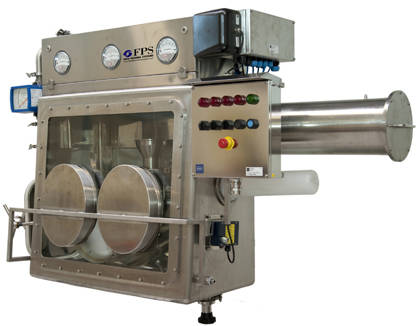
'An isolator can be used to house an cone mill, for containment during milling.'
One of the foremost considerations when contemplating the use of an isolator is the product charging phase. From a containment perspective, it is important to understand where the product is coming from and in which kind of container (rigid, flexible, IBC etc.). in order to define a suitable isolator introducing method (pre-chamber, RTP, Split Valve, direct connection on process equipment etc.)
Proper planning at this stage will make the product charging/discharging phase easier. A proper connection system is required for the mill charging/discharging phase to reduce dust generation and increase product yield. Accurate weighting is also available at the cone mill discharging stage, by means of a custom designed and built packing-off station.
For specific product conditioning requirements, it is possible to integrate various milling techniques to achieve the desired outcome. For example, inerting of the mill head, or cryogenic milling with an individual control system for exhaust gas by means of dedicated ventilation. Sterile configuration of the system may also prove beneficial within the isolator. Sterilisation media by means of steam and VHP may also be considered.
Finally, an isolator can prove highly flexible, as it can be used for processes other than cone milling. It is possible to use the same isolator to integrate pin-mills (PSD 50-150 ?m), Q-mills (PSD 20-100 ?m) and spiral jet-mills (PSD 1-20 ?m).
4. Conclusion
In conclusion, there are many considerations when cone milling a product. However, one of the foremost considerations is the issue of dust generation.
An isolator offers a simple and effective solution to this problem, by containing the dust within the isolator, ensuring it does not escape to atmosphere. Meanwhile, the isolator draws upon the flexibility offered by a cone mill, enabling quick and easy tooling changes.
Another advantage of an isolator is that it is an excellent means of achieving an explosion-proof process. The isolator itself creates an ATEX environment for milling, ensuring the entire process does not need to be changed to comply with the necessary requirements.
To integrate a cone mill with an isolator requires many variables to be considered. However, by properly evaluating the process, one can easily achieve an optimal process, which conforms to modern processing guidelines, simply by integrating these two pieces of highly flexible processing equipment.
A 'Shared-Knowledge' Article between Hanningfield (UK) and F.P.S. (Italy)
Standard ‘Uni-Mill’ Specifications
|
Contact |
Non-Contact |
|
|
Stainless Steel |
AISI 316L |
AISI 304 |
|
Surface Finish |
180 grit (Ra <0.76 micron) |
150 grit (Ra <1.06 micron) |
|
Welds |
Ground flush/polished |
As laid or better |
|
Seals, Gaskets, O-Rings etc. |
FDA Compliant Silicone |
FDA Compliant Materials |
-
|
|
Specification |
|
Throughput |
Min. 200kgs/hr / Max. 7,000kgs/hr |
|
Motor Size |
Min. 0.375kW / Max. 15kW |
|
Voltage |
3 phase, 415v, 50Hz. |
|
Typical Impeller Speed |
480 RPM to 3600 RPM |
|
Screen Type |
Round, Grater, Square or Slotted |
|
Impeller Type |
2-bar impeller – Square Bar or Round Bar |
|
Special Requirements |
Mobile, Height Adjustable, ATEX etc. available |
|
Other |
No metal-to-metal contact |
Download Brochure:
![]() Conical Screen Mills (Uni-Mill Series)
Conical Screen Mills (Uni-Mill Series)![]() FDA Guidelines for Uni-Mill
FDA Guidelines for Uni-Mill











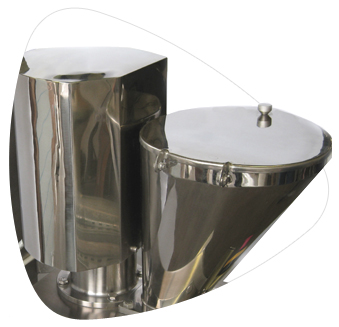



























 Unknown
Unknown Unknown
Unknown Mozilla
Mozilla